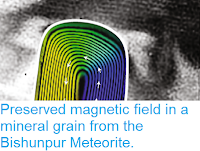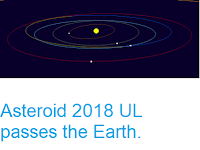Asteroid 2002 VE68 passed by the Earth at a distance of about 5 631 000
km (14.6 times the average distance between the Earth and the Moon, or 3.76% of the distance between the Earth and the Sun), slightly before 9.45 pm
GMT on Sunday 4 November 2018. There was no danger of
the asteroid hitting us, though were it to do so it would have
presented a significant threat. 2002 VE68 has an estimated
equivalent
diameter of 150-470 m (i.e. it is estimated that a spherical object
with
the same volume would be 150-470 m in diameter), and an object of this
size would be predicted to be capable of
passing through the Earth's
atmosphere relatively intact, impacting the ground directly with an
explosion that would be 9350-235 000 times as powerful as the
Hiroshima
bomb. Such an impact would result in an impact crater 2-8 km
in
diameter
and devastation on a global scale, as well as climatic effects that
would last decades or even centuries.
Image of 2002 VE68 taken on 7 November 2010. Asteroid is the elongate object at the centre of the picture, which moved during the course of the 120 Second exposure. Martin Mobberley/Wikipedia.
2002 VE68 was discovered on 11 November 2002 by the Lowell Observatory
in Flagstaff, Arizona. The designation 2002 VE68 implies that it was
the 1705th asteroid (asteroid E68) discovered in the first half of
November 2002 (period 2002 V).
2002 VE68 has a 225 day orbital period, with an elliptical orbit tilted at
an angle of 9.01° to the plain of the Solar System which takes in to
0.43 AU from the Sun (43% of the distance at which the Earth orbits the
Sun, and slightly more than the distance at which Mercury orbits the Sun) and out to
1.02 AU (2%
further away from the Sun than the Earth). This means that close
encounters between the asteroid and Earth are fairly common, with the
last thought to have happened in November 2015 and the next predicted
in October 2021. Although it does cross the Earth's
orbit and is briefly
further from the Sun on each cycle, 2002 VE68
spends most of its time
closer to the Sun than we are, and is therefore classified as an Aten
Group Asteroid. This also means that the asteroid has occasional close
encounters with the planet Mercury, with the last calculated to have
occurred in May 2017, and the next predicted for November 2022. As
an asteroid possibly larger than 150 m in diameter that occasionally
comes within 0.05 AU of the Earth, 2018 MG7 is also classified
as a Potentially Hazardous Asteroid.
The calculated orbit of 2002 VE68. Minor Planet Center.
2002 VE68 is also a quasi-satellite of Venus, also circling Venus on a retrograde path on each orbit of the Sun, passing through the L4 and L5 Lagrangian points (60% ahead and behind Venus on the same orbital path) as well as in as far as the orbit of Mercury and out as far as the orbit of Earth. It is believed to have been on this orbital path for about 7000 years, having been knocked onto it by a close encounter with the Earth.
The motion of 2002 VE68 for the next 150 yr. The coordinate system rotates with Venus. Orbits of Mercury, Venus and Earth are also (schematically) illustrated. Mikkola et al. (2004).
See also...
Follow Sciency Thoughts on Facebook.









